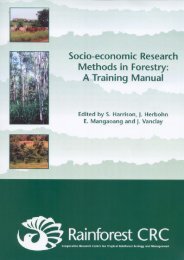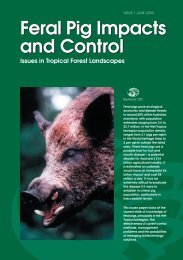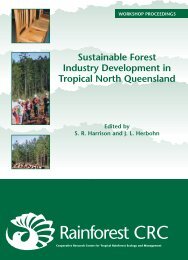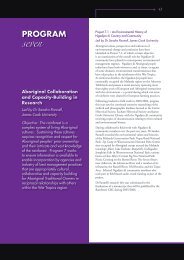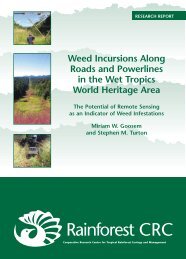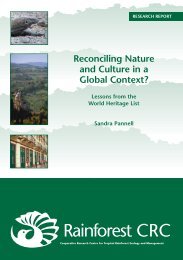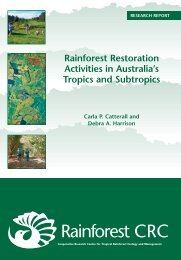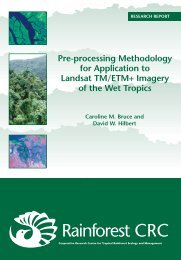Reconciling Nature and Culture in a Global Context? - Rainforest ...
Reconciling Nature and Culture in a Global Context? - Rainforest ...
Reconciling Nature and Culture in a Global Context? - Rainforest ...
You also want an ePaper? Increase the reach of your titles
YUMPU automatically turns print PDFs into web optimized ePapers that Google loves.
S<strong>and</strong>ra Pannellmethodology of modern heritage conservation, with its emphasis upon scientificmeasurement, classification <strong>and</strong> evaluation, “can <strong>in</strong>advertently mummify or destroy aspectsof value by disregard<strong>in</strong>g the less tangible <strong>and</strong> subtler elements of cont<strong>in</strong>uity” (2004: 50).It is apparent from the current management plan that the Ata Modo <strong>and</strong> the other ethnicgroups <strong>in</strong> <strong>and</strong> around the Park have failed the authenticity requirements for preservationentailed <strong>in</strong> the methodology adopted by The <strong>Nature</strong> Conservancy. Their cultural beliefsabout ora are dim<strong>in</strong>ished as ‘folk tales’, their traditional customs are reported to be“dw<strong>in</strong>dl<strong>in</strong>g” at a rapid rate, local heritage is reduced to the status of a h<strong>and</strong>ful of ‘culturalrelicts’ (WCMC 1994), <strong>and</strong> it appears that they have also lost their ability to engage <strong>in</strong>“susta<strong>in</strong>able fish culture” (loc. cit.). Accord<strong>in</strong>g to a TNC fact sheet on ‘alternative livelihoods’,“for generations, villagers liv<strong>in</strong>g <strong>in</strong> an around Komodo have carefully harvested the sea’sriches <strong>in</strong> susta<strong>in</strong>able ways” (TNC n.d. f: 1). However, it appears that nowadays these verysame people are engaged <strong>in</strong> “overfish<strong>in</strong>g <strong>and</strong> destructive fish<strong>in</strong>g practices” (loc. cit.). Itseems that while TNC is adept at recognis<strong>in</strong>g <strong>and</strong> sav<strong>in</strong>g biodiversity around the world, itdoes not appear able to identify a range of traditional community fish<strong>in</strong>g activities as anyth<strong>in</strong>gbut ‘destructive’ or specifically dist<strong>in</strong>guish who, out of the more than 20,000 people liv<strong>in</strong>g <strong>in</strong><strong>and</strong> around the Park, is responsible for such practices, if anyone. Through the ‘Komodo Fish<strong>Culture</strong> Project’, The <strong>Nature</strong> Conservancy aims to “steer” local people towards a “thriv<strong>in</strong>gmariculture <strong>in</strong>dustry” (TNC n.d. f: 1). In keep<strong>in</strong>g with the translocal vision of TNC, this projectwill also “protect one of the world’s most biologically diverse <strong>and</strong> productive mar<strong>in</strong>eenvironments” (loc. cit.). In Komodo National Park, the burden of deferred consumption ofthe assets of this ‘biodiversity bank’ is firmly placed upon the local population, rais<strong>in</strong>gquestions about who actually benefits from this World Heritage-<strong>in</strong>scribed, UNESCO-listedbiosphere reserve.THE GOOD, THE BAD AND THE UGLY: A POSTSCRIPT FROMKOMODO NATIONAL PARK, 2005Back <strong>in</strong> 1981, when the social science researcher, Michael Hitchcock, visited the newlyformed Komodo National Park, it didn’t appear that the Komodo isl<strong>and</strong>ers were reallybenefit<strong>in</strong>g from the environmental <strong>and</strong> tourism successes that often come with theestablishment of a protected area. Indeed Hitchcock concludes that, “overlooked by theauthorities <strong>and</strong> lack<strong>in</strong>g the appropriate skills <strong>and</strong> education, the isl<strong>and</strong>ers have been unableto participate <strong>in</strong> the new developments” (1993: 313). Hitchcock suggests that the isl<strong>and</strong>ers’marg<strong>in</strong>alisation partially stems from the fact that the Park’s planners were “primarilyconcerned with environmental conservation rather than the needs of the local population”(loc. cit.). Apparently, the problems posed by the presence of people with<strong>in</strong> the Park were tobe solved by “resettl<strong>in</strong>g several villages outside the reserve” (loc. cit.).As Jim Igoe observes, along with many other commentators, “the historical creation of parksoften <strong>in</strong>volved the eviction of local people” (2004: xi). An <strong>in</strong>kl<strong>in</strong>g of the global magnitude ofthis ‘management’ practice is found <strong>in</strong> the UNESCO-sponsored overview of ‘Human Use ofWorld Heritage Natural Sites’ (Thorsell <strong>and</strong> Sigaty 1998). While the authors of this studyreport that “the majority of natural World Heritage sites [73 out of 126 ‘natural’ <strong>and</strong> ‘mixed’sites], have no resident human population” (ibid: 3), exam<strong>in</strong>ation of these supposedly‘natural’ sites reveals that substantial human populations, <strong>in</strong> some cases number<strong>in</strong>g tens ofthous<strong>and</strong>s of people, live immediately adjacent to these protected areas. One of the moreobvious conclusions to be drawn from this material is that people lived <strong>in</strong> these spaces priorto their declaration as a protected area, whether as a World Heritage property, conservationreserve, or national park. In the 47 ‘natural’ World Heritage sites where resident humanpopulations have not been rendered <strong>in</strong>visible by the convenience of a l<strong>in</strong>e on a map <strong>and</strong>ahistorical statistics, the degree to which their presence <strong>and</strong> <strong>in</strong>volvement <strong>in</strong> shap<strong>in</strong>g an38




